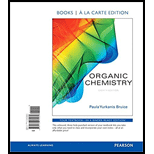
Concept explainers
(a)
Interpretation:
The mechanism for the given reaction should be determined.
Concept Introduction:
Acid Catalysed addition of water: When water is added to

The electrophile
(b)
Interpretation:
The mechanism for the given reaction should be determined.
Concept Introduction:
Acid Catalysed addition of water: When water is added to alkene in the presence of an acid,
Addition of a hydrogen halide to an alkene:
An
The
The general reaction is represented as:

Want to see the full answer?
Check out a sample textbook solution
Chapter 6 Solutions
ORGANIC CHEMISTRY (LL)-W/MOD.MASTERING.
- a. Propose a mechanism for the reaction of acetic anhydride with water.b. How does this mechanism differ from the mechanism for the reaction of acetic anhydride with an alcohol?arrow_forwardSlow addition of organolithium reagent A to B afforded C, an intermediate in the synthesis of the chapter-opening molecule, resiniferatoxin. Draw a stepwise mechanism for this process.arrow_forwardBromoetherification, the addition of the elements of Br and OR to a double bond, is a common method for constructing rings containing oxygen atoms. This reaction has been used in the synthesis of the polyether antibiotic monensin (Problem 18.34). Draw a stepwise mechanism for the following intramolecular bromoetherification reaction.arrow_forward
- When A is treated with aqueous −OH, the major product is compound B, which undergoes ester hydrolysis and decarboxylation to form C. Draw a stepwise mechanism for the conversion of A to B.arrow_forwardCoumarin, a naturally occurring compound isolated from lavender, sweet clover, and tonka bean, is made in the laboratory from o hydroxybenzaldehyde by the reaction depicted below. Draw a stepwise mechanism for this reaction. Coumarin derivatives are useful synthetic anticoagulants.arrow_forwardQuinapril (trade name Accupril) is used to treat high blood pressure andcongestive heart failure. One step in the synthesis of quinapril involvesreaction of the racemic alkyl bromide A with a single enantiomer of theamino ester B. What two products are formed in this reaction?arrow_forward
- Propose a mechanism for the formation of (A)arrow_forward(S)-Glutamic acid is one of the 20 amino acid building blocks of polypeptides and proteins (Chapter 27). Propose a mechanism for the following conversion.arrow_forwardDraw a stepwise mechanism for the sulfonation of an alkyl benzene such as A to form a substituted benzenesulfonic acid B. Treatment of B with base forms a sodium salt C that can be used as a synthetic detergent to clean away dirt (see Problem 3.22).arrow_forward
- susceptible to nucleophilic attack a to b c only a only a and carrow_forwardCoumarin, a naturally occurring compound isolated from lavender, sweet clover, and tonka bean, is made in the laboratory from o-hydroxybenzaldehyde by the reaction depicted below. Draw a stepwise mechanism for this reaction. Coumarin derivatives are useful synthetic anticoagulants.arrow_forwardDraw the carbonyl and Grignard necessary to prepare the following alcohol as a racemic mixture. List ALL possible routes.arrow_forward
 Organic ChemistryChemistryISBN:9781305580350Author:William H. Brown, Brent L. Iverson, Eric Anslyn, Christopher S. FootePublisher:Cengage Learning
Organic ChemistryChemistryISBN:9781305580350Author:William H. Brown, Brent L. Iverson, Eric Anslyn, Christopher S. FootePublisher:Cengage Learning
